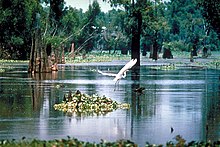Highlights:
• Cost for assimilation wetlands averaged $0.60/gallon of treatment capacity.
• 2° and 3° treatment costs averaged $4.90 and $6.50/gallon, respectively.
• Wetland assimilation is less sensitive to cost increases than traditional systems.
Abstract:
In recent decades, water quality standards for wastewater treatment have become more stringent, increasing costs and energy required to reduce pollutants. Wetland assimilation is a low-cost and low-energy alternative to traditional tertiary wastewater treatment where secondarily treated and disinfected municipal effluent is discharged primarily into freshwater forested wetlands in coastal Louisiana. In this paper, costs per gallon of treatment capacity for conventional secondary and tertiary treatment were compared to those for assimilation wetlands. Cost analysis reports were used to determine costs per gallon of treatment capacity for conventional wastewater treatment facilities, including costs for conveyance between the collection system and the assimilation wetland site, and between the treatment and disposal sites if they could not be co-located. Capital and operation and maintenance costs were considered. Because all wastewater treatment plants are required to treat at least to secondary standards, costs for primary and secondary treatment were combined. If necessary, these costs were adjusted for inflation to 2017 dollars using an average inflation rate of 2.19 percent and a cumulative inflation rate of 50.84 percent. To determine costs per gallon of treatment capacity for assimilation wetlands, actual costs provided by the project engineer were used when available. To simulate the future costs of facility construction and compare the replacement costs of conventional secondary and tertiary wastewater treatment facilities and treatment wetlands in the context of energy prices, U.S. Bureau of Labor and Statistics (BLS) data for the price index for inputs to construction were used, as were the Energy Information Administration (EIA) data for the price of crude oil to model future wastewater treatment plant construction and operation costs. The cost for the Mandeville assimilation wetland included $1 million for the price of the land. Future costs of treatment facility construction and operation were modeled relative to average price of construction inputs between 1998 and 2015 using the projected price of crude oil. When treatment costs were compared among secondary, tertiary, and assimilation wetlands, mean cost for assimilation wetlands was $0.60 per gallon (>1 MGD capacity) compared to $4.90 and $6.50 per gallon for secondary and tertiary treatment, respectively. The lower total costs and energy requirements for assimilation wetlands result in lower variability in the price of construction and operation. Wetland assimilation is more economical than conventional wastewater treatment, especially compared to advanced secondary and tertiary treatment. It is likely that energy costs will increase significantly in coming decades. Because conventional secondary and tertiary treatment are energy intensive, increases in energy costs will significantly increase the costs of these treatment systems. Treatment systems that combine lower technology (e.g., oxidation ponds) secondary treatment with wetland assimilation are less likely to be impacted by rising energy costs than traditional wastewater treatment.

Atchafalaya Basin https://en.wikipedia.org/wiki/Wetlands_of_Louisiana
by Rachael G.Hunter 1, John W.Day 1 and 2, Adrian R.Wiegman 3, Robert R.Lane 11. Comite Resources, Box 66596, Baton Rouge, LA 70896, USA
2. Dept. of Oceanography and Coastal Science, Louisiana State University, Baton Rouge, LA 70803, USA1
3. Rubenstein School of Natural Resources, University of Vermont, Burlington, VT 05401, USA
https://doi.org/10.1016/j.ecoleng.2018.09.020
Ecological Engineering
Available online 25 September 2018
No comments:
Post a Comment